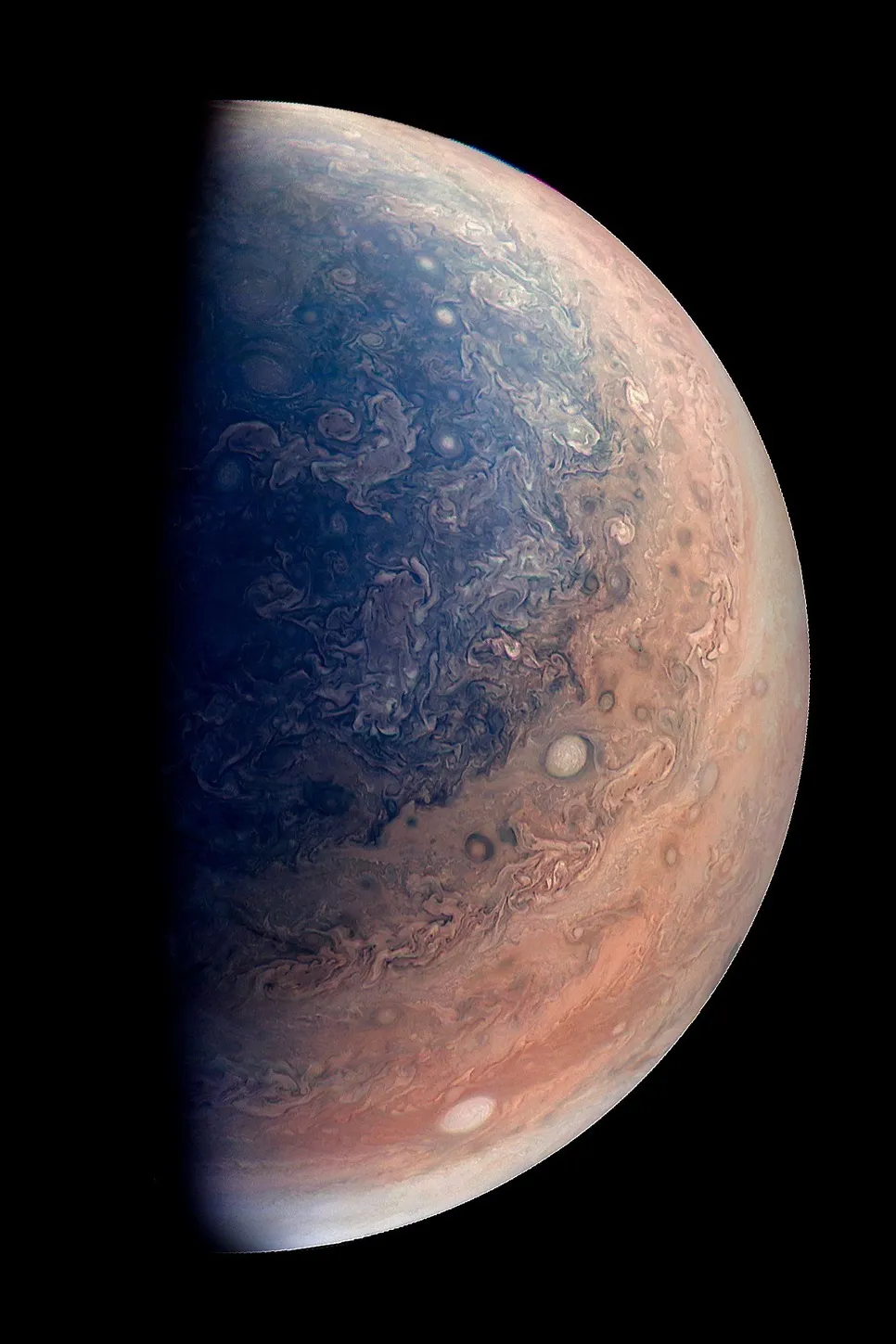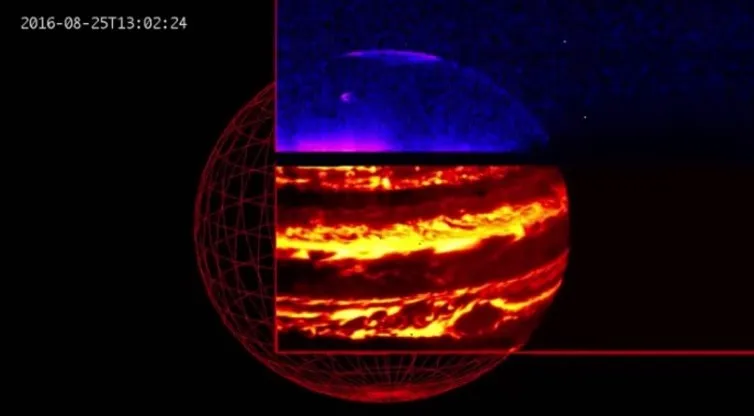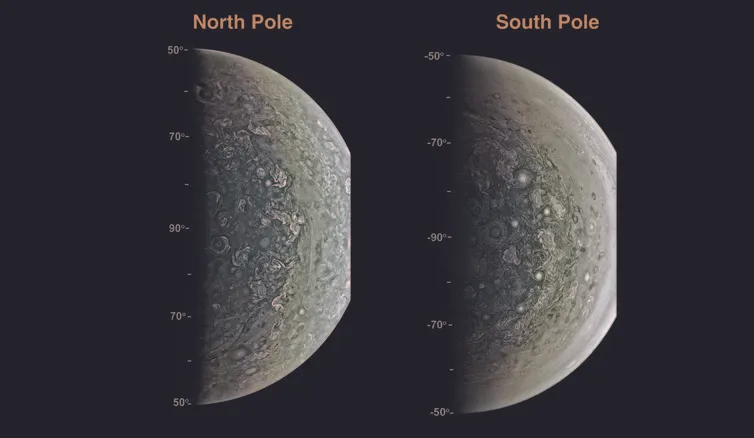Ten months after its nerve-wracking arrival at Jupiter, NASA’s Juno mission has started to deliver – forcing scientists to reevaluate what they thought they knew about the giant planet. The first findings from Juno, published in Science, indicate that many aspects of Jupiter have defied expectation – including the strength of its magnetic field, the shape of its core, the distribution of ammonia gas and the weather at its poles. It certainly makes this an exciting time to be a Jupiter scientist.
Juno arrived at Jupiter in July 2016, and began a long, looping first orbit that took it far out from the planet before zipping back in for its first scientific close-up (perijove) on August 27. It is this fleeting meeting that the new studies are based on. Today, despite initial problems with Juno’s engine and spacecraft software, the mission has settled into a regular pattern of close perijoves every 53.5 days – the sixth such flyby happened on May 19, the seventh will be on July 11.
Mysteries in the deep

Intriguingly, much of the ammonia is concentrated into an equatorial plume, rising from the depths of Jupiter to the cloud-tops due to some powerful up-welling force. Scientists are likening this to Earth’s Hadley cell, with plumes dredging ammonia up from hundreds of kilometres below.One of Juno’s key strengths is its ability to peer through the overlying shroud of clouds to study the gases below, such as the cloud-forming substance ammonia. Flows of ammonia help form Jupiter’s distinctive features. The gas was expected to be well mixed, or drenched, below the topmost clouds. That idea has been turned on its head – the ammonia concentration is much less than expected.
We’ve known that ammonia is enhanced at Jupiter’s equator for some time, but we never knew how deep this column went. However, it’s important to remember that this is only one location on Jupiter, and that Earth-based infrared observations suggest that the plume may not be this strong elsewhere around Jupiter’s equator, but could be patchy. Only with more perijove passes will we begin to understand the strange dynamics of Jupiter’s tropics.
We’ve never been able to see this deep before, so even the first observations from Juno’s microwave instrument provide a treasure trove of new insights. These show that the banded structure that we see at the surface is really just the tip of the iceberg – Jupiter exhibits banding all the way down to 350km. This is much deeper than what we’ve generally thought of as Jupiter’s “weather layer” in the upper few tens of kilometres. What’s more, that structure isn’t the same all the way down – it varies with depth, indicating a large, complex circulation pattern.
Gravity and magnetic fields
The surprises didn’t stop here. Juno can probe even deeper into the planet by monitoring small tweaks to the spacecraft’s orbit by the gravity field of Jupiter’s interior. Ultimately, these will be used to assess Jupiter’s core, although that cannot be done from a single perijove pass. Most scientists believe that the planet has a dense core made up of around ten Earth masses of heavy elements and occupying a small fraction of the radius. But the new measurements are inconsistent with any previous model – possibly hinting at a “fluffy” core dispersed out to half of Jupiter’s radius.
Indeed, Jupiter’s interior appears to be anything but uniform. We have to remember that scientists have spent years developing models of the interior of Jupiter based on sparse data taken from great distances – Juno is now testing these models to the extreme because it is flying so close.

Jupiter has the most intense planetary magnetic field in the solar system, causing a pile-up where the solar wind is slowed down (known as the bow shock). Juno first passed through this region and into the Jovian magnetosphere on June 24. At its closest approach, the strength of Jupiter’s magnetic field was twice as strong as any model had predicted and much more irregular.
That’s important, because it suggests that the magnetic field could be generated at shallower depths than expected, above the “metallic hydrogen” layer that is thought to exist at very high pressures. If proven, this has substantial implications for studies of magnetic fields at all of the giant planets. Perhaps the Cassini mission will be able to confirm whether this is the case as it makes its final measurements of Saturn’s magnetic field before it crashes into the planet in September.
Chaos at the poles
If you’ve ever been lucky enough to see Jupiter through a telescope, you’ll be familiar with the organised, striped structure of whiter zones and dark brown belts. These colourful bands are bordered by powerful jet streams whizzing east and west around the planet. On Saturn, this organised, banded structure persists all the way to the poles, with one jet showing a strange hexagonal wave pattern encircling a hurricane-like polar cyclone. But Jupiter’s poles are different. Gone is the organised structure of jets. There’s no evidence for hexagons or anything like it. And instead of one cyclone, we see multitudes, surrounded by a whole host of chaotic and turbulent features.

With the ability to see structures as small as 50km, Juno’s camera has revealed numerous bright cyclones of a variety of appearances – some appear sharp, some have clear spirals, some are fluffy and diffuse, and the largest is some 1400km across. That’s about the same distance between London and Majorca. These bright storms sit on top of dark clouds, giving the appearance of “floating” on a dark sea, and it will be some time before we understand the lifetimes and motions of these storms.
You might imagine that, faced with throwing out models that have taken careers to develop, scientists might be a little glum. But the exact opposite is true. A mission like Juno, accessing regions that no robotic spacecraft has ever probed before, is designed to test the models to the extreme. If they break, then the search to find the missing pieces of the puzzle will provide deeper insights into the physics of the Jovian system. All these surprises have come from just the first perijove encounter, and I’m sure there are plenty more revelations to come.
Leigh Fletcher, Royal Society Research Fellow, University of Leicester
[image]This article was originally published on The Conversation. Read the original article.
Follow Science Focus onTwitter,Facebook, Instagramand Flipboard
